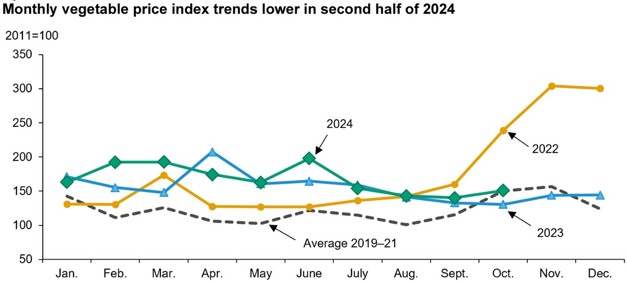In late July, temperatures reached 10 degrees (or more) above normal in parts of California's North Coast, the Central Coast, the Sacramento Valley, the San Joaquin Valley, and the Cascade-Sierra Mountains. As of November 2024, USDA's Risk Management Agency had earmarked over $22 million for crop losses incurred by California's vegetable and pulse producers during June, July, and August of 2024. This is 27 percent more than the $17.8 million in heat-related indemnity payments allocated for the same period in 2023, and 67 percent more than the 5-year average ($13.6 million).
Fresh vegetables
In 2024, the fresh market vegetable sector experienced a mixed year, with notable increases in grower prices for key crops like lettuce, onions, carrots, and tomatoes due to unfavorable growing conditions. Cauliflower and celery experienced stable or declining prices, but overall availability met consumer demand despite regional disruptions.
Mushrooms
In 2023/24 (July–June), domestic producers grew 659 million pounds of mushrooms, valued at $1.09 billion. The 2023/24 crop was 9 percent smaller than the previous season. The total organic mushroom volume represented approximately 10 percent of total mushroom production. The preliminary 2023/24 per capita availability for all mushroom products (including truffles) is 3.3 pounds per person, a 6 percent decline from 2022/23.
Fresh market vegetables
During the first 4 months of 2024, changes in fresh vegetable prices varied by crop. While tomatoes and onions started the year at elevated levels, with tomatoes stabilizing by midyear and onions gradually declining after their early peak, carrot prices have steadily risen beyond the first quarter. Other fresh vegetables, including celery and cauliflower, have generally seen prices rise above their 2023 averages throughout much of 2024. These price increases led to a 7.6 percent increase from September 2024 to October 2024 in the USDA, National Agricultural Statistics Service (NASS) vegetable price index, which represents an aggregate measure of fresh vegetable prices. The October 2024 index was 16 percent higher than last year, but 37 lower than October 2022.
Extreme weather complicated the summer and fall of 2024 for domestic vegetable and pulse producers. In late July, temperatures exceeded 10 degrees above normal in parts of California's North Coast, the Central Coast, the Sacramento Valley, the San Joaquin Valley, and the Cascade-Sierra Mountains. In Florida and the southeastern coast, two hurricanes dominated headlines: Helene (which made landfall on September 26 near Perry, Florida) and Milton (which made landfall near Siesta Key, Florida on October 7). The University of Florida's Institute of Food and Agricultural Sciences (IFAS) preliminary estimates noted that Helene caused between $10.5 million and $38.2 million in losses to Florida's vegetable, melon, and potato producers. IFAS is in the process of analyzing losses associated with Hurricane Milton.
To view the full report, click here.
 For more information:
For more information:
USDA
Tel: +1 (202) 720-2791
Email: [email protected]
www.usda.gov




